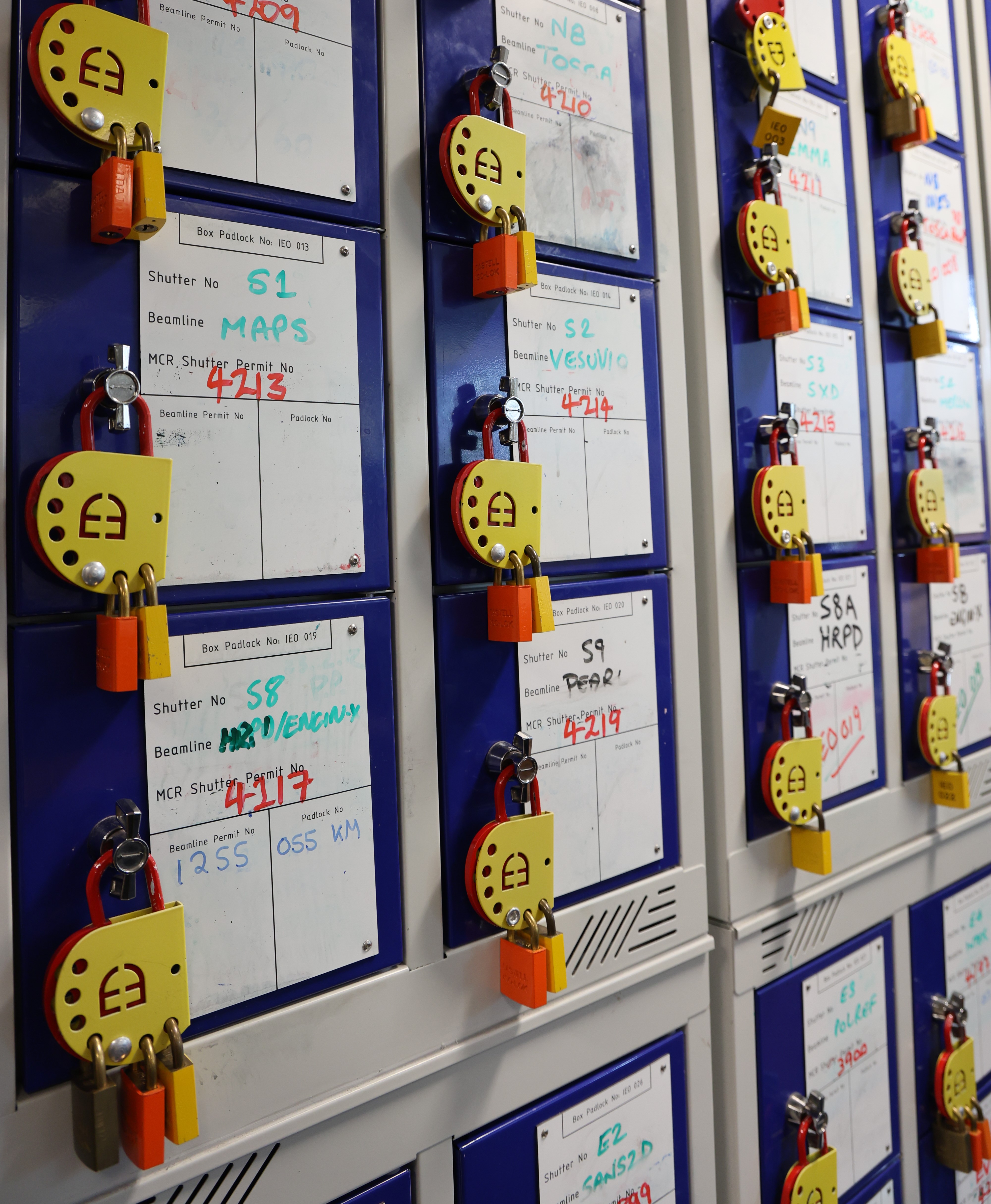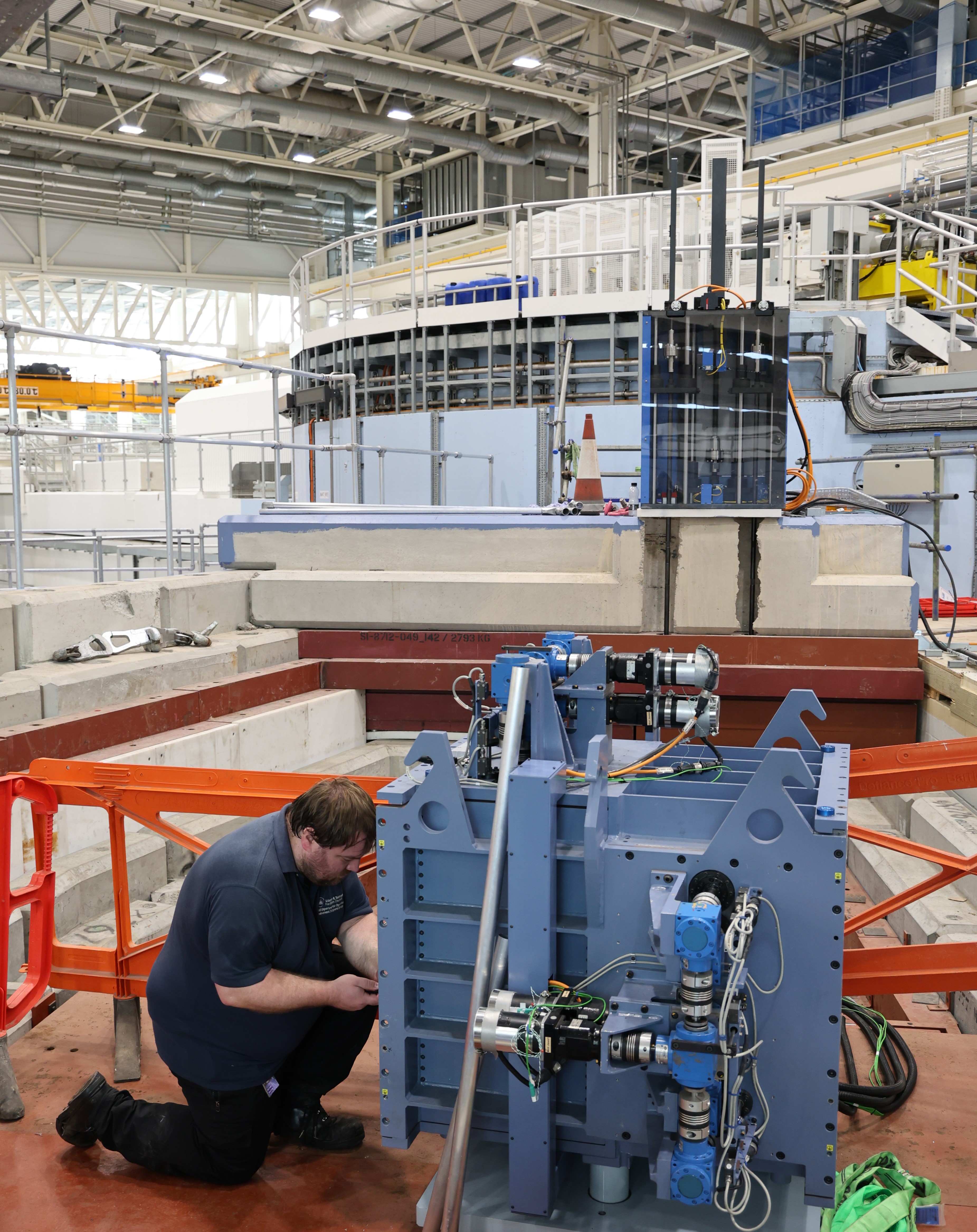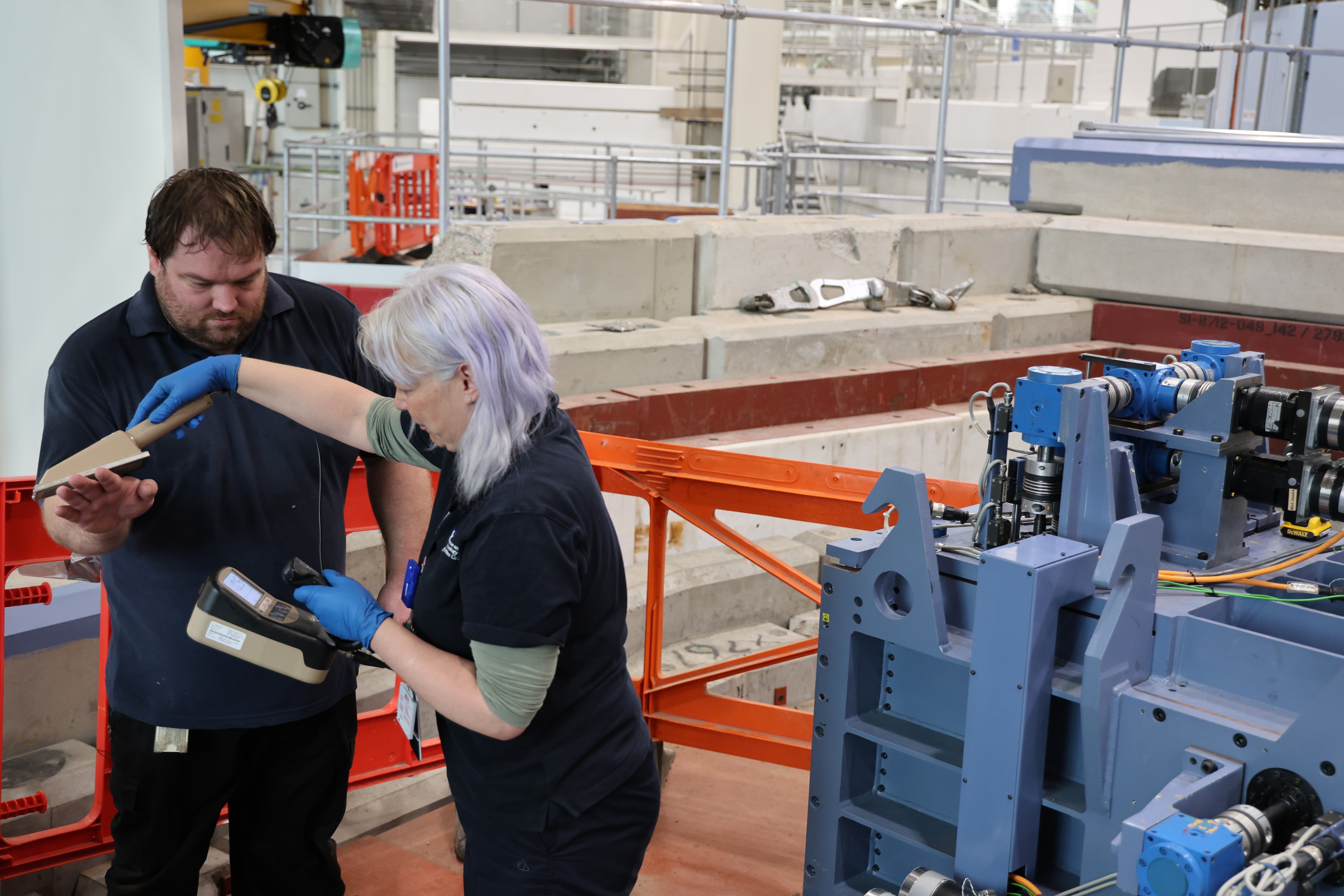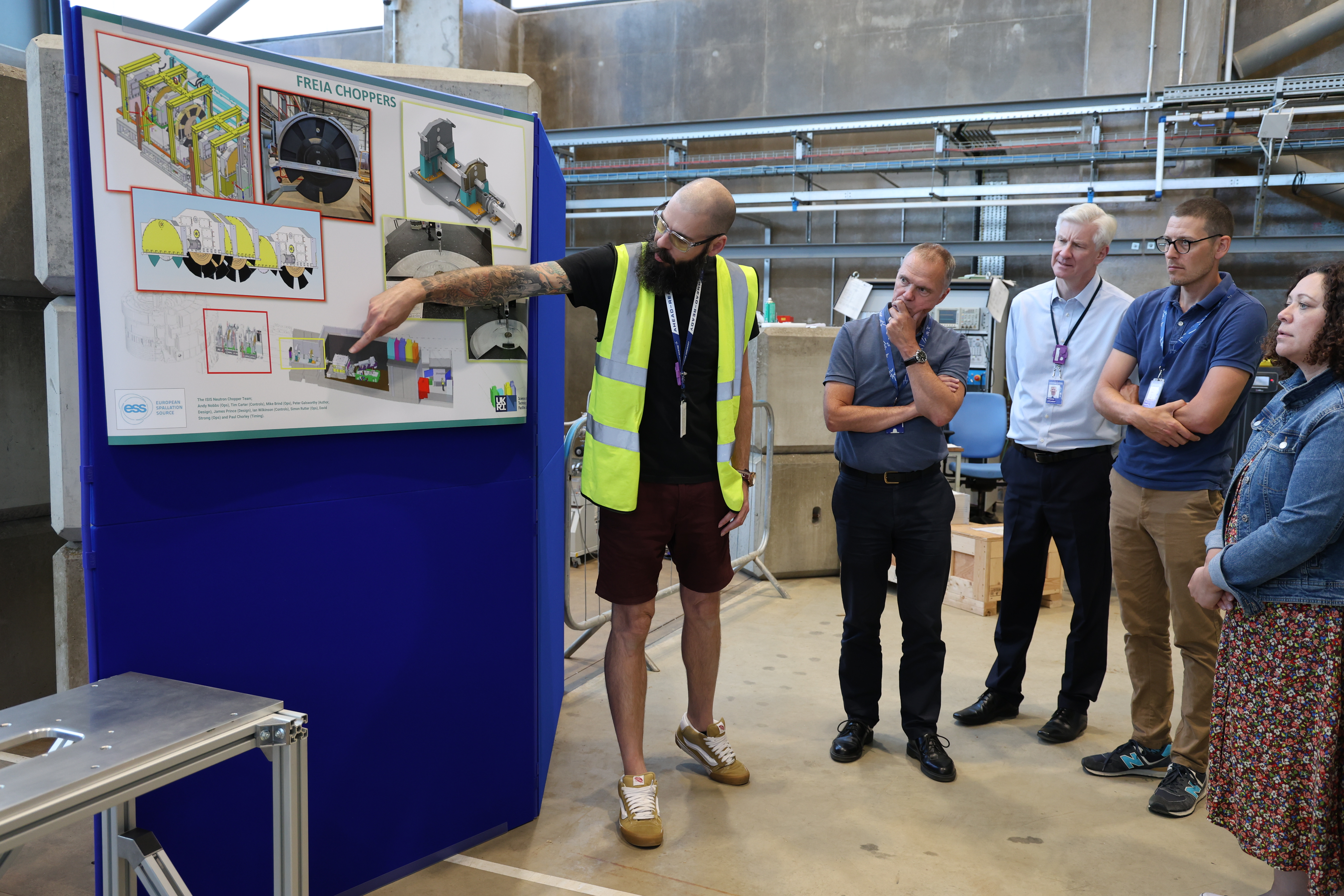The reality is that the keys get handed over to our technical and engineering teams (literally!) and they have to get all of the planned maintenance of the instruments and the accelerator finished before the next cycle, as well as having to slot in any unexpected tasks. Here we pick out a few examples to give a taster of what happens when the beam is off, from the accelerator, through the proton beamline and instruments and all the way to Sweden (almost…)
 Handing over the keys
Handing over the keys
Responsibility for ISIS instruments is handed to the Instrument Operations (IO) Group during shutdown periods for maintenance and upgrades. In the same way that when you take your car to the garage for a service you would give the garage the keys and they take responsibility for it, they need to make sure it isn't used when it is unsafe before they are finished.
The instrument shutters are locked by ISIS Instruments and Projects Section Manager John Crawford and IO Section Leader Josef Lewis and their teams, and then the keys stored in the main control room, who issue permits for monitoring access. Each permit is locked away with a padlock associated with each job that needs doing, plus one for the IO group, creating a two-layer system that ensures the safety of any staff working on the instruments. Once a job has been completed, the padlock is removed, leaving just one. At the end of the shutdown, John and Josef return the permits to the MCR, exchanging them for the shutter keys and enabling the instruments to be handed over to the scientists.
Image, right, shows the locked permit boxes.
Dipole magnet
The ISIS synchrotron relies on the bending power of ten dipole magnets. As well as those in use, there is an additional magnet in case a quick replacement is required. Over the last 20 years, the dipole magnets have been refurbished, with the insulating material between the copper wires in the coils replaced. During this shutdown, one of the spare magnets needed to be removed from the synchrotron so that the coils could be replaced. Before the shutdown, the accelerator team prepared the copper wires ready for them to be installed.
 After the user cycle had finished, and the radiation levels of equipment in the synchrotron had gone down to safe working levels, the huge plug closing the wall between the synchrotron hall and target station two was removed. For the 30-tonne dipole to be removed, it's not possible to use the crane as the wall between the two is in the way.
After the user cycle had finished, and the radiation levels of equipment in the synchrotron had gone down to safe working levels, the huge plug closing the wall between the synchrotron hall and target station two was removed. For the 30-tonne dipole to be removed, it's not possible to use the crane as the wall between the two is in the way.
The team use the synchrotron crane to lift the magnet to the outside of synchrotron ring, and then it's loaded onto the ISIS hovercraft “Hissing Sid", where Mechanical Technician, Chris Young steered it out before parallel parking it in the assembly area.
Image, left, shows Chris Young steering the dipole on the hovercraft.
EPB2 pump replacement
The Extracted Proton Beamline (EPB) directs high energy protons from the accelerator towards the targets. The protons need to be kept under vacuum to ensure they don't lose energy or change direction.
Vacuum pumps supporting beam tubes so if they need to be serviced or replaced then re-alignment needed. The pumps approaching the end of their life, so team decided to future-proof and come up with a new design. Graduate Abigail Basham designed a pump that would sit on wheels and connect to the beam pipe with a quick-release fixing, to enable them to be removed without disrupting the alignment. As the EPB extends into TS2, the distance between the beam pipe and the floor increases, not only leading to an Alice-in-Wonderland type experience as you walk down it, but also for some increased logistical challenges when concerning how high above the group the pump fixings need to be.


Image, left, shows the measurement of the beam tube alignment, and image, right, shows the team fitting the new pump.
ChipIr jaws
The ChipIr instrument has two sets of perpendicular jaws that open to direct the right number of neutrons to the beamline. In the last cycle, one of these jaws stopped working. To find out what the problem was, the Instrument Operations team needed to have a look. However, this is not as easy as it sounds, as they jaws sit in the collimator pit, under multiple layers of shielding. After waiting a few days for the radiation levels to drop, the shielding was removed – a process that takes over a day – and the jaws were lifted out.
On inspection, they saw that one of the lead screws that controlled the broken jaw had failed, meaning that the whole jaw would need to be replaced. This job is too big to be completed before the beginning of the next cycle. Instead, Mike Starling from the group made sure the broken jaw was made safe and adjusted the others to minimise the likelihood of any failure occurring to them.
Any work that involves maintenance to equipment that has been in the neutron beam requires the assistance of the health physics team. On this occasion, Gemma Morgan was present to find out whether any dust created was active and to monitor Mike's exposure. After a quick test, it was clear that the work was safe and that the drilling was not exposing any active material.


Image, left, shows Mike working on the jaws, and image, right, shows Gemma monitoring him for radation exposure.
FREIA tours
During the shutdown, the team working on the FREIA beamline for the European Spallation Source (ESS) welcomed staff from across ISIS to come and have a look at the progress that had been made. Across seven tours, 64 people came to see the choppers, shutters, collimators and detector table that will be sent over to Sweden next year.
The FREIA beamline will be assembled at ISIS before being shipped over to the ESS in Sweden. The components designed and built by ISIS include a collimation system, which consists of two motion stages each requiring a pair of rails to be precisely aligned for parallelism, and the detector bench: a large motion-controlled system that uses three axes working in unison to ensure the high precision detector is always looking at the sample.
Throughout the process, our ISIS technicians and STFC apprentices build and survey these components, adjusting them based on real-time data feedback. This iterative process requires considerable planning, attention to detail, and a range of expertise.


Images, above, show the tours of the FREIA beamline.
